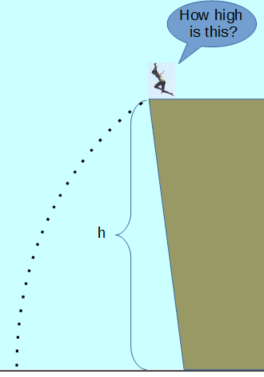Object Height by time to drop
Tags | |
UUID | 552e355c-817e-11e5-9770-bc764e2038f2 |
The Object Height by Time to Drop formula computes the approximate  Time to drop height (h) of an object (building, bridge, cliff) by the time (t) it takes an object to free fall from the height.
Time to drop height (h) of an object (building, bridge, cliff) by the time (t) it takes an object to free fall from the height.
INSTRUCTIONS: Choose units and enter the following:
- (t) Duration of the fall (fall time).
Height of Fall (h): The calculator return the approximate height in meters and feet. However, these can be automatically converted to other length units (e.g. feet) via the pull-down menu.
The Math / Science
The formula for height based on time of fall is:
where:
- h is the height of the fall
- g is the acceleration due to gravity
- t is the duration of the fall
This is a simplification of the general formula of distance traveled under constant acceleration:
where:
- x is the initial distance
- v is the initial velocity
- a is the constant acceleration
For distance traveled in a fall, x is zero, v is zero and a is g - acceleration due to gravity in our example). This formula does not account for the effects of air resistance (force of drag).
Use a stopwatch to measure the time it take for a heavy object to drop from the top of an object to the bottom. This formula will provide the approximate height based on that measurement in time. This formula does not take into account the effect of air friction, but a heavy smooth object has relatively little effect. Also, make sure that the object is dropped over the side with no initial up or down motion since that will affect the time of drop.
 Free Fall Calculators
Free Fall Calculators
- Free Fall (time): Computes the duration of time that an object will be in free fall based on the height and the acceleration due to gravity.
- Free Fall (distance): Computes the distance that an object will be in free fall based on the duration of the fall and the acceleration due to gravity.
- Free Fall (Velocity at Impact): Computes the final velocity of an object after a free fall based on the height and the acceleration due to gravity.
- Free Fall (Energy on Impact): Computes the kinetic energy at impact based on the height of free fall, acceleration due to gravity and the mass of the object.
- Model Rocket Altitude: Computes the estimated maximum altitude of a rocket based the distance from the launch point and the angle to top point of flight (zenith).
- Object Height by Time to Drop: Estimates the height of an object based on the time it takes for an object to drop from the top of it.
- Elevation of Object (angles and separation): Computes the height of an object based on two angle measurements and the distance between them.
- Distance Traveled at Constant Acceleration: Computes the distance traveled by an object after a period of time, based on its initial distance from the origin, initial velocity and a constant acceleration.
- g (acceleration due to gravity at sea level): Acceleration due to Gravity (g) at sea level on Earth is 9.80665 m/s2.

Equations and Data Items
Calculators
Collections
- Comments
- Attachments
- Stats
No comments |

